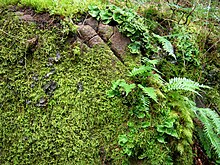Polypodium glycyrrhiza
| Polypodium glycyrrhiza | |
|---|---|

| |
| Scientific classification | |
| Kingdom: | |
| Division: | |
| Class: | Polypodiopsida/Pteridopsida (disputed)
|
| Order: | |
| Family: | |
| Genus: | |
| Species: | P. glycyrrhiza
|
| Binomial name | |
| Polypodium glycyrrhiza | |
Polypodium glycyrrhiza, commonly known as licorice fern, many-footed fern, and sweet root, is an evergreen fern native to western North America, primarily in a narrow strip in southern Alaska, southwestern Yukon Territory, western British Columbia, Washington, Oregon, and California, though two highly disjunct populations are known from Idaho and Arizona. It thrives in a humid climate, prevailing in areas with cool and moist summers and warm and wet winters. P. glycyrrhiza can often be found growing on the trunks and branches of deciduous trees, particularly bigleaf maple, but is also often found on rocks, logs, and wet, mossy humus. Habitat elevation is lowlands below 600 meters.[1]
Licorice fern acquires its name from its licorice-flavored rhizome, which was chewed for flavor by numerous Native American groups, including the Squamish, Shishalh, Comox, Nuxalk, Haida, and Kwakwaka'wakw. The rhizomes were also usually used medicinally as a treatment for the cold and sore throats. [2]
Spores are located in rounded sori on the undersides of the fronds, and are released in cool weather and high humidity.
This species is a diploid, and is one parent of several species of hybrid origin:
- Polypodium vulgare (with Polypodium appalachianum)
- Polypodium hesperium (with Polypodium amorphum)
- Polypodium calirhiza (with Polypodium californicum)
Cultivation
This species is in cultivation, and the cultivar 'Longicaudatum' has gained the Royal Horticultural Society's Award of Garden Merit.[3] It is not as rock-dependent as are many related species. A hybrid between this species and Polypodium californicum has been named Polypodium calirhiza and is in cultivation.
References
- ^ http://ucjeps.berkeley.edu/cgi-bin/get_JM_treatment.pl?85,86,89
- ^ Pojar, Jim (2004). Plants of the Pacific Northwest Coast. Edmonton: Lone Pine Publishing. ISBN 978-1-55105-530-5.
- ^ "RHS Plant Selector - Polypodium glycyrrhiza 'Longicaudatum'". Retrieved 28 May 2013.
External links
- Polypodium
- Ferns of the United States
- Ferns of California
- Flora of Alaska
- Flora of British Columbia
- Flora of Idaho
- Flora of the Northwestern United States
- Flora of Oregon
- Flora of Washington (state)
- Flora of California
- Flora of the Sierra Nevada (U.S.)
- Natural history of the California Coast Ranges
- Natural history of the San Francisco Bay Area
- Pteridophyta of the Americas
- Garden plants of North America
- Fern species
- Fern stubs
